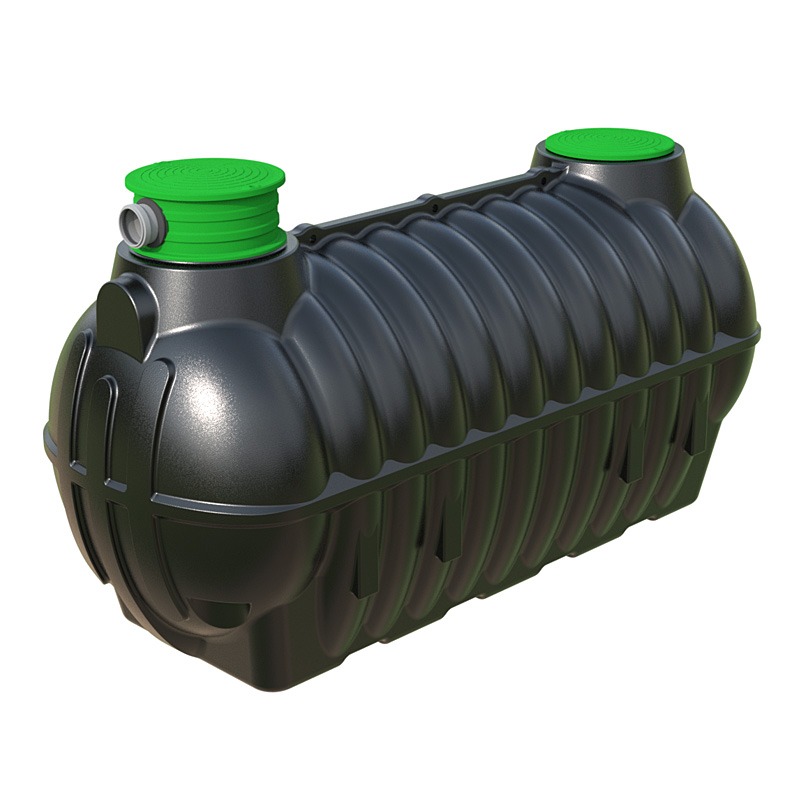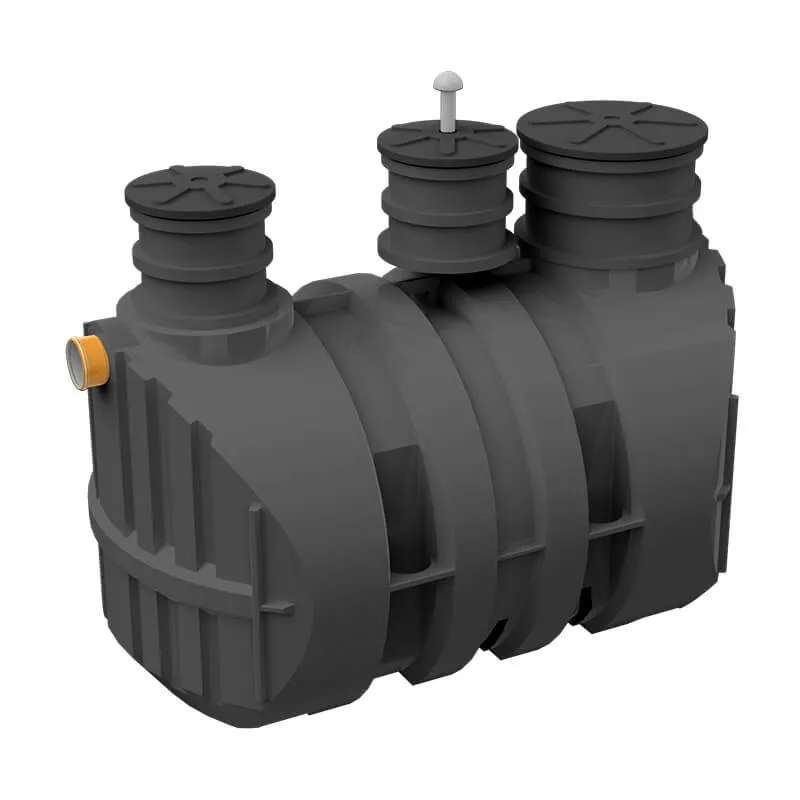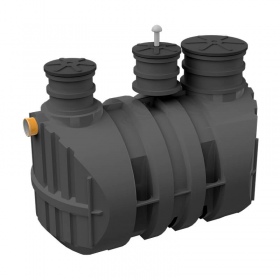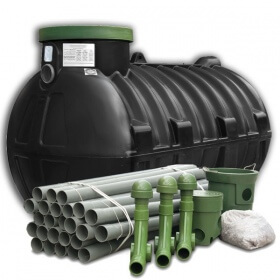- perm_identity Mateusz
- favorite 1 likes
- remove_red_eye 23446 views
- comment 0 comments

Domestic wastewater treatment plants law and location requirements
The law clearly stipulates that every property owner is required to connect the property to the sewage system. When it is impossible or uneconomical to do so, a septic tank (cesspool) or sewage treatment plant must be installed. A domestic wastewater treatment plant is a modern solution that allows the discharge of treated wastewater into the ground or water. It reduces the cost of sewage collection. A domestic treatment plant is environmentally friendly and almost completely service-free. The cost of operating such a device is minimal. Such a solution has a number of advantages, but it also requires compliance with specific law requirements.
Law requirements for domestic wastewater treatment plants
The main problems that accompany planning to build your own wastewater treatment system are the law requirements. The most common question is whether it is necessary to have a construction permit or only a notification? According to the current Construction Law, only a notification is required for the construction of a wastewater treatment plant with a capacity of up to 7.5 m3/d or a septic tank with a capacity of up to 10 m3.
In addition to the construction permit, you must have a water permit for the discharge of wastewater into the environment. In this case, if you are discharging wastewater from your own household or farm up to 5 m3 the permit is not necessary. The regulations refer to this as normal water use.


The law that regulates the conditions that must be met when discharging wastewater and rainwater and snowmelt into water or land is the Decree of the Minister of Maritime Affairs and Inland Navigation dated July 12, 2019.
The building of wastewater treatment plants also involves consideration of water and groundwater parameters. Details of the requirements for different types of treatment plants are included in the table.
Type of wastewater treatment plant | Soil requirements | Distance from groundwater level | Size of the plot (2) |
with infiltration drainage | Well or medium permeable (sands, gravels and loess) | > 1,5 m (1) | big (3) |
biological | - infiltration planned in the ground - good permeability, - outside the boundaries of the plot (6) | insignificant | small (4) |
hydrobotanical | - infiltration planned in the ground - good permeability, - outside the boundaries of the plot (6) | insignificant | big (5) |
1 If the groundwater is too high, a filter mound (embankment) can be used, of such height that the minimum distance of the drains from the groundwater level is maintained.
2 The need to maintain the minimum distances on the plot, regulated by law, also determines the size of the plot on which the elements of the treatment system must be placed.
3 The system including drainage can take up to 90 m2, depending on the amount of wastewater to be discharged
4 The treatment plant can take up from 8 -10 m2
5 The area for the trench with the drainage and the components of the treatment plant depends on the number of household members, assuming 4 people, about 15 m2.
6 Soil requirements do not matter then, but a Water Law Permit is required
For more information on the different types of wastewater treatment plants and recommendations on which one to choose, see our article on the subject. We invite you to read our guides.
The law (Regulation of the Minister of the Environment of November 18, 2014) also conditions the degree of purity of wastewater that will be discharged to water from the treatment plant. It distinguishes between areas for locating treatment plants outside the agglomeration and in the agglomeration. Wastewater, coming from the agglomeration, should not exceed the maximum permissible values of pollutant indicators specific to the p.e. (table). For areas outside the agglomeration, wastewater pollution values should be min 20% for BOD5 and min 50% for total suspended solids content.
No. | Indicator name | Unit | P.E. - the equivalent population of the agglomeration | |||
2000 - 9999 | 10000-14999 | 15000-99999 | 100000< | |||
1 | Five-day biochemical oxygen demand (BOD5 at 20 ⁰C), determined with the addition of a nitrification inhibitor | mg O2/l min. % reduction | 25 or 70-90 | 25 or 70-90 | 15 or 90 | 15 or 90 |
2 | Chemical oxygen demand (CODCr) determined by the bichromate method | mg O2/l min. % reduction | 125 or 75 | 125 or 75 | 125 or 75 | 125 or 75 |
3 | Total suspended solids | mg/l min. % reduction | 35 or 90 | 35 or 90 | 35 or 90 | 35 or 90 |
4 | Total nitrogen (sum of Kjeldahl nitrogen (NNorg + NNH4) nitrite nitrogen and nitrate nitrogen) | mg N/l min % reduction | 15 | 15 or 70-80 | 15 or 70-80 | 10 or 70-80 |
5 | Total phosphorus | mg P/l min % reduction | 2 | 2 or 80 | 2 or 80 | 1 or 80 |
Source: Annex No. 3 to the Regulation of the Minister of the Environment of November 18, 2014 on conditions to be met when discharging wastewater into waters or into the ground, and on substances particularly harmful to the aquatic environment.
To summarize, in order for the discharge of wastewater to take place as part of the normal use of water on one's own land without the need for a construction and water permit, the conditions should be met:
- ensuring sufficient treatment of wastewater from contaminants,
- wastewater is discharged in an amount of up to 5 m3
- the capacity of the treatment plant up to 7.5 m3/d or a septic tank with a capacity of up to 10 m3
- groundwater is separated by a minimum of 1.5 m layer of soil from the place where sewage is introduced
For more information, see our article Notification of domestic wastewater treatment plant. You are cordially invited to read its contents.
Location and recommendations for a domestic wastewater treatment plant
The location of a private wastewater treatment plant is strictly defined by law. The act that provides such guidelines is, among others, the Water Law. It describes the permissible distances of wastewater treatment plants from selected sites. The location guidelines are shown schematically in the following graphic.

The minimum foundation distances of the tank, which are included in the table, must be kept:
Listed areas | Element of a domestic sewage treatment plant | Minimum distances [m] | |||
For a tank up to m3 | For a tank from 10 to 50 m3 | For a tank from 50 m3 | |||
Drinking water well | Casing of the liquid waste tank | 15 | |||
Installation of water infiltration in the ground | 30 | ||||
Single-family, recreational, or homestead building* | Liquid waste tank | 5 | 30 | x** | |
Other buildings | 15 | 30 | x** | ||
Boundary of neighboring plot***, road, pedestrian way | For single-family, recreational or homestead buildings | Zbiornik na nieczystości ciekłe | 2 | 7,5 (from the border of the plot) 10 (from the road) | x** |
For other buildings | 7,5 | 7,5 (from the border of the plot) 10 (from the road ) | X** | ||
Swimming pools, public beaches*** | Domestic wastewater treatment | 1000 | |||
Telecommunications cables | Components of a domestic wastewater treatment plant, e.g., an ecological septic tank, a system for infiltrating treated wastewater into the ground | 1,0 | |||
Electric wires | 0,5 – 3,0 | ||||
Water supply | 0,8 | ||||
Gas connection | 1,5 | ||||
Vegetation (trees and other) | Domestic wastewater treatment | Recommendation min. 3 | |||
*Exception is when the flow-through sealed underground treatment tank is connected to the ventilation system more than 0.6 m above the top edge of windows and doors. In this situation, the tank can be sited at any distance from buildings.
**Distances determined on an individual basis in accordance with the technical expertise accepted by the state provincial sanitary inspector.
***Drainless tanks may be located at a distance of less than 2 m from the border of the plot, if there are similar facilities on the neighboring plot, but provided that the other distances are kept.
****The law also makes it illegal for sewage to be directed into lakes and their tributaries if the time of sewage inflow is less than 24 hours. It is forbidden to direct wastewater directly into standing water or groundwater.

The recommendation to locate the tank at an appropriate distance from vegetation is based on a common-sense approach. The root system could damage treatment plant components in the long run. In addition, roots hinder foundation and maintenance work on the plant.
It is unfavorable to place the tank in the depressions of the land, due to the possibility of flooding by rainwater. As a result, this can cause sewage to flow out. In addition, it puts unnecessary strain on the installation. Such placement of the treatment plant can effectively reduce its efficiency.
It is also worth noting the favorable location of the installation in relation to the access road. This will make any maintenance work and visits by the septic tank cleaning team much easier. Be aware of the possibility of unpleasant odors coming from inside the tank. A properly functioning installation should not generate them in large quantities. However, it is recommended to take this aspect into account when planning construction.
When planning the construction of a treatment plant, it is worth paying attention to the area of the freezing zone. If the connection will be built in this zone, it is recommended to use a DN160 diameter of the sewer pipe and possible restrictions on the length of the pipes. This will minimize the risk of blockages in the pipes under the influence of low temperatures. If the connection needs to be longer, a greater pipe slope should be used or insulation should be used. Similarly, you can consider the conditions for the foundation of a drainless tank. If its shallow foundation is planned, it is recommended that the structure be double-walled. This will definitely reduce the freezing of the contents, thanks to the air insulation between the walls.
 We have all the necessary components for building your own wastewater treatment system. Our experts will provide all the information on domestic wastewater treatment plants. They will also help you choose the right solution. We cordially invite you to visit the website of our store and encourage you to contact us.
We have all the necessary components for building your own wastewater treatment system. Our experts will provide all the information on domestic wastewater treatment plants. They will also help you choose the right solution. We cordially invite you to visit the website of our store and encourage you to contact us.
 We have all the necessary components for building your own wastewater treatment system. Our experts will provide all the information on domestic wastewater treatment plants. They will also help you choose the right solution. We cordially invite you to visit the website of our store and encourage you to contact us.
We have all the necessary components for building your own wastewater treatment system. Our experts will provide all the information on domestic wastewater treatment plants. They will also help you choose the right solution. We cordially invite you to visit the website of our store and encourage you to contact us.Related products
Bioflow FIX sewage treatment plant -...
- PE from 1 to 10 people
- Tank capacity 3500 - 12000 l
- Solutions for septic tank adaptation
star_border star_border star_border star_border star_border
0 Review(s)
Price
PLN9,225.00
PLN7,500.00
tax excl
Bioflow II biological sewage treatment plant
- Biological, flow-through wastewater treatment plant
- The sewage treatment plant process takes place in one EcoLine tank
- Easy to use, easy to install!
star star star star star
1 Review(s)
Price
PLN14,084.00
PLN11,450.41
tax excl
Eko Standard drainage sewage treatment plant
- Household sewage treatment plant
- Traditional drainage version
- Models for 4 to 6 people
star star star star star
2 Review(s)
Price
PLN3,094.13
Regular price
PLN3,476.55
PLN2,515.55
tax excl
Lowest price: PLN3,094.13 0%
Water drainage treatment plant
- Drainage wastewater treatment plant
- With conventional drainage
- Solutions for 4 or 6 or 8 or 10 people
star_border star_border star_border star_border star_border
0 Review(s)
Price
PLN3,521.06
Regular price
PLN3,956.25
PLN2,862.65
tax excl
Lowest price: PLN3,521.06 0%
Comments (0)
No comments at this moment




